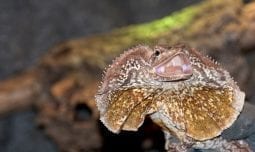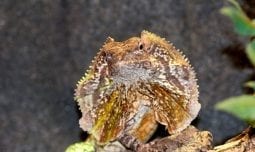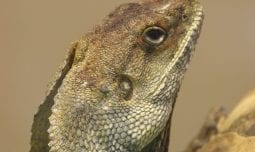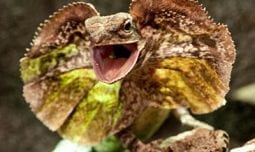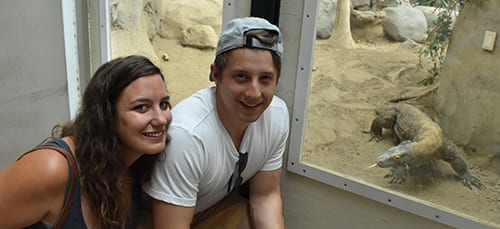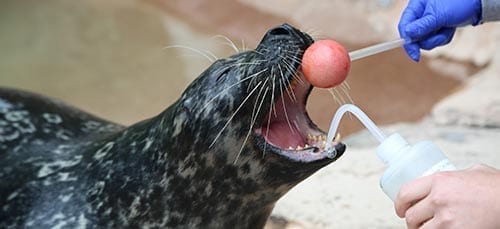Classification
Class Reptilia
Order Squamata
Family Agamidae
Genus Chalamydosaurus
Species kingii
Habitat & Range
This species of lizard lives in warm temperate dry forests and semi-arid grassy woodlands.
The frilled lizard is found in northern Australia, southern New Guinea.

Frilled Lizard
Chalamydosaurus kingii
The name of this spectacular lizard comes from the large leathery ruff or frill of skin around the neck. When the lizard is alarmed or faced with a potential threat, it opens its mouth widely thus erecting the frill in a flash of startling orange color. When the frill is fully extended it can reach 12 inches (30.5 cm) across which makes the lizard appear much larger and more threatening to any potential predator. The resulting surprise usually allows the frilled lizard to make a quick escape. But if necessary, the lizard may hiss, jump toward the potential threat and repeatedly lash its tail on the ground to add to the threat. The frilled lizard prefers to run away rather than fight but is capable of inflicting painful bites, with its large canine teeth, on any predator.
Adaptations
Hind Leg Locomotion
This species is well known for its bipedal locomotion when running. When disturbed, the lizard rears up on its hind legs and dashes for the safety of the nearest tree.
Up In The Trees
The frilled lizard spends most of its time on the trunks and limbs of trees hunting insects. It will descend to the ground to catch other insects or search for other food.
Larger Than Life
The name of this spectacular lizard comes from the large leathery ruff or frill of skin around the neck. When the lizard is alarmed or faced with a potential threat, it opens its mouth widely thus erecting the frill in a flash of startling orange color. When the frill is fully extended it can reach 12 inches (30.5 cm) across which makes the lizard appear much larger and more threatening to any potential predator. The resulting surprise usually allows the frilled lizard to make a quick escape. But if necessary, the lizard may hiss, jump toward the potential threat and repeatedly lash its tail on the ground to add to the threat. The frilled lizard prefers to run away rather than fight but is capable of inflicting painful bites, with its large canine teeth, on any predator.
Physical Description
- Frilled lizards can reach a total length of 27-37 inches (70-95 cm)
- Males weigh about two pounds (900 g) while the slightly smaller females weigh about one pound (450 g).
- Their scaly skin is grey-brown in color and the tail is striped with a dark tip.
- The tongue and mouth are pink or yellow.
- The distinctive “frill” located behind the head is yellow to black in color with orange at the base when the frill is opened up. The frill can be up to 12 inches (30.5 cm) across.
Diet
What Does It Eat?
In the wild: Insects, spiders, termites and small lizards.
At the zoo: Insectivore diet.
What Eats It?
Feral cats prey on frilled lizards.
Social Organization
Frilled lizards are solitary except during breeding.
Life Cycle
Males are territorial and appear to use their impressive frill to attract females. Mating occurs during the wet season from October to March. The female lays eight to 23 eggs per clutch and may produce two clutches during one breeding season. The eggs hatch in about 70 days. The hatchlings are tiny and weigh only onetenth to two-tenths of an ounce (3-5 g). There is no parental care for the hatchlings – they immediately must fend for themselves. Lifespan in the wild is unknown.
Fun Facts
- The frilled lizard is part of the dragon family.
- The Australians call the frilled lizard the “dragon lizard.”
- The frilled lizard is the reptile emblem of Australia and was depicted on the two-cent coin.
- The frill cannot be erected unless the jaws are opened wide. The two actions are synchronous.
- Frilled lizards in captivity seldom display their frill.
Conservation Status
IUCN Status: Not Evaluated

Download the App!
Get the FREE Denver Zoo app today, and be a pro the next time you visit the Zoo. You’ll get access to the Zoo map, daily activities and schedules, animal facts, and more. You can even load your membership card onto the app for additional convenience. It puts everything you need for an amazing Zoo experience right into the palm of your hand!
